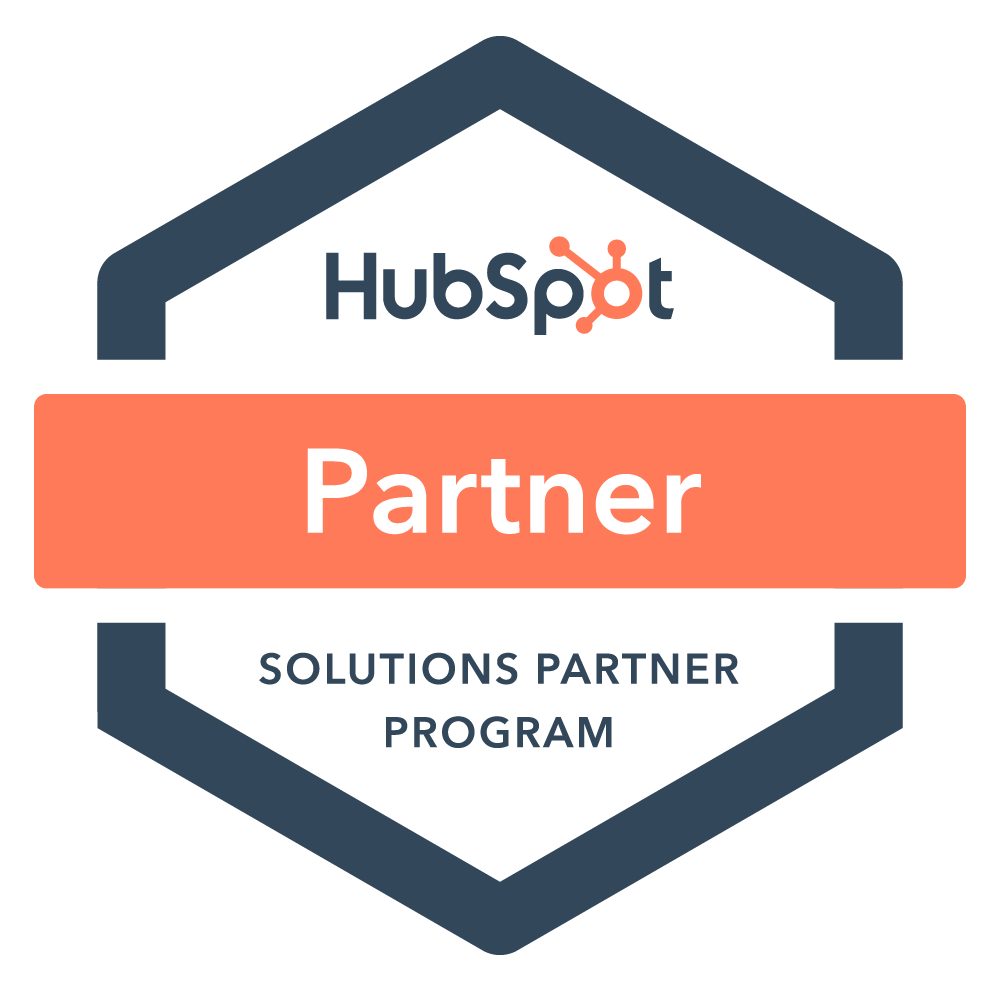In 2025, getting the right message in front of the right people is nothing but crucial. More noise, more disruption, and way too much AI to handle. That calls for this back-to-basics, explaining how you can grow trust, demand, and love from your audience by kickstarting an inbound marketing strategy.
The Fundamental Question: Inbound vs Outbound
From the top, we need to talk about inbound and outbound marketing. Far too much is said about whether it's one or the other. This comes from a lack of understanding of how the two can interplay.
Here’s what you need to know.
Inbound Marketing Is The Flywheel Of Attraction
 The inbound model is built on the idea of relationships.
The inbound model is built on the idea of relationships.
It's a flywheel designed to be self-sustaining, fueled by product, content, and search engine marketing (see that graphic from our friends at HubSpot.)
You attract strangers, engage prospects, create customers, and delight them with an awesome product that builds viral demand.
You do this by making what you say more valuable than what you want in return. The flywheel pulls people into your world and keeps them engaged to create growth.
So why is inbound marketing a snug fit for SaaS start-ups?
It’s Content-Centric
Inbound marketing revolves around creating and sharing high-quality, informative, and relevant content. SaaS companies often have a complex product that needs to be made simple. Content does that.
You Attract the Right Audience
Inbound is a waiting game. It's a long play. Your audience will eventually need your solutions. The reality is that not everyone realizes that at the same time (hello to Rogers' innovation curve), so you need to feed information out there to people at every part of their journey.
The "right" audience is anyone who fits your ideal customer profile and buyer personas. You need to meet them where they are with the content they need when they need it. Not the opposite.
Build Trust and Authority
Providing valuable content consistently makes you trustworthy. That pattern of content plus it being high quality with a unique take builds confidence.
More Bang From Your Buck
Inbound marketing can be more cost-effective than traditional outbound methods. Creating content that continues attracting visitors over time reduces the over-reliance on ad spending, as you're earning the traffic that's coming to your site without parting ways with a buck.
Brands that publish 15 blog posts per month convert 1,200 new leads per month
HubSpot
Outbound Marketing: Pushing Your Message
Outbound marketing, on the flip side, is about pushing messages to a broad audience. It's about direct mail, radio, television, OOH (Out Of Home) advertising, cold calling, print media, etc. On its own, it won't give a SaaS company sustainable growth, because:
It Interrupts
It's nails on a chalkboard. Instead of being consent-based, i.e. I've consumed information so I expect to see more, it's coming from a cold start. It's interruptive by its nature. And, well, we don't like that in 2024.
It's Expensive
"Traditional" marketing channels are costly. If you have a limited budget, going that route isn't something you can keep doing.
Scatter Guns Fail
Outbound campaigns go big. Product marketing best practices always show that you need to target personas and ideal customer profiles, not everyone. Don’t waste money reaching irrelevant people.
A Whisper In The Wind (Tracking Is Like)
Measuring the success of outbound isn't easy. You'll need to take data and add in some guesswork, and even then attribution isn't simple.
What Makes Inbound Right For SaaS?
Good question.
SaaS buyers are typically well-informed, researching to the tune of 20+ pieces of content on average before engaging with sales reps.
These are the types of people who want a solution. Content is the way to guide them towards resolving that need.
27% of the buying journey is spent researching independently online
Gartner
If we look at the makeup of SaaS companies, we see more reasons why a trust-based marketing strategy - like inbound - fits in with the industry.
Subscription-Based Model
It's stating the obvious, but a monthly subscription model means you need to be at your very best at all times. That's not just about the product or success teams, it's through the line. Marketing needs to keep adding value and showing why you should be trusted.
High Competition
Did we mention SaaS is highly competitive? Red oceans would be an understatement. There are very few industries with such an environment. You could argue that creating content isn't the only key to differentiation, but it is a bare necessity.
Educational Selling
We know SaaS buying journeys are long. Whether applying a PLG (product-led growth) play or a traditional SLG (sales-led growth) model, you need to educate as you sell.
If you don't create content to help the research process, when buyers come to decide on their way forward, you'll either be bottom of the barrel or nowhere to be found.
Lowering Customer Acquisition Costs
We all want to spend less to get more. To our finance friends, we say this: driving down Customer Acquisition Costs (CAC), strengthening sales efficiency metrics, and shorter paybacks are part of inbound.
Inbound marketing requires good SEO knowledge, research skills, the ability to collect data, and a copywriter + designer to make it flow.
That's considerably less than an outbound approach. Better yet, great quality is evergreen!
Listening To Customers
Customers and users make or break a SaaS start-up. If you're doing the right thing with product, marketing, sales, and success, then you're feeding the voice of the customer into what you do.
Integrating this into your content is a strand of inbound marketing. If you capture the questions, challenges, and stories of your customers, you address those for future buyers.
That keeps your customer base engaged and elevates their voice.
Being Specific
I often say that if you are talking to everyone, you're talking to no one. That's why product marketing is so crucial to getting your start-up right. With an idea of who you are, what you do, and how you help, you then focus on who you help.
When you know your audience, you build content that they want, need, and love. Sure, you can get smart with the format of the content and how to integrate it with your product, but above all, it's about choosing a niche and going all in.
Expertise To Show
Establishing yourselves as an industry leader is crucial to going to market, whatever your market. With inbound, you are the author of your destiny.
Producing content that shows who you are rubs credibility and expertise onto you, your team, and the product as a whole.
How To Start Your Own Inbound Journey
Embarking on inbound is exciting - but it's also often a case of not knowing what you should know… until you do know it. Let's help you.
1. Get To Know Your Audience Inside Out
Inbound's value comes from connecting with the right audience. This starts with knowing your target audience inside out. That's why product marketing goes hand in hand with your inbound efforts.
Always start with buyer personas - separate from user personas, which product teams base development around. Here’s what’s involved:
Buyer Personas
Buyer personas are semi-fictional representations of your ideal customers based on market research and real data about your existing customers.
Here's an example persona: With these, you’re going to better understand your audience's pain points, needs, behaviors, and preferences. It’s a blueprint for success.
With these, you’re going to better understand your audience's pain points, needs, behaviors, and preferences. It’s a blueprint for success.
Content and Messaging Alignment
Once you have personas, you align content and messaging with their preferences. This ensures your content addresses the issues and questions that matter most to your audience.
Personalization
Personalized content is the point of inbound. Personas help you to tailor content. That can be on a level based on challenges, or it can be personalized content on a vertical, say manufacturing.
2. Start Producing Content
Build a plan
This is going to take a collection of skills:
- Keyword research
- Asking customers about their challenges
- Content brainstorming
- Persona-led refinement of ideas
- Mapping content to pain points
From here, you should be looking to create a list of content to produce. You should create a system for mapping the content to the buyer journey, showcasing the type, theme, and more. Here's ours:
Find Your Groove
Ever since college, I've found I'm creative with music on. Even when in the library, that's how I was productive. You need to find that groove and put the needle in it - whatever makes you creative, follow it.
From there, you're going to start producing drafts of content on a schedule that works for you. Work best in the evening? Great! Need that cup of joe to get going? Head out. Just be consistent.
Mix Up The Content-Type
Fatigue will set in with inbound marketing. That's because great content isn't produced from a series of AI prompts. Great content is from the heart. But that doesn't mean you must stick to written content. Try eBooks, quizzes, webinars, podcasts, videos, and infographics.
Be A Problem-Solver
Address your audience’s challenges. There's a reason Marcus Sheridan's "They Ask You Answer" is a best-seller. The advice is pure and simple. If someone asks a question, answer it. That means they have a problem. Solve it with solution-oriented content like templates and checklists to offer guidance and insights. We all love free advice.
Write down every question you’ve ever received from a prospect or customer who was asking you to compare two or more things...Once you’ve made this list, address these questions honestly and transparently throughout your digital marketing effort
Marcus Sheridan, They Ask You Answer
2. Have a Great SEO Strategy
In 2024, search engine visibility is paramount. For SaaS vendors, this means optimizing content for users driving searches (not the other way around.) You can figure that out through these steps.
Keyword Research
Take your personas and conduct thorough keyword research to find potential customers' keywords and phrases when searching for similar solutions.
Google Keyword Planner, Semrush, and Moz are great here. You want to find long-tail keywords - i.e. those that have lower volume but you can answer perfectly.
On-Page SEO
Optimize your content by putting keywords in titles, headings, and text. Ensure that your content is structured logically, with clear headings and subheadings. And be sure to answer the question the content is about.
Link Building
Develop a link-building strategy to earn high-quality backlinks from authoritative websites. Quality backlinks boost your content's search engine ranking - read: searchers find you more trustworthy.
3. Building a Community Around Your Brand With Social
Social media plays a vital role in inbound marketing. Leverage social media platforms to engage with your audience, amplify your content, and build a community around your brand. Here's how
Find Communities
Whether you're lurking on Reddit, scrolling through LinkedIn, or visiting X, there's a conversation to be had. Take the time to find those places and observe them to see the types of content shared.
Get Sharing
When you're ready, you can start to share your content. That isn't just a link and two lines of copy. Drive a real conversation and ask for thoughts. Create polls, add comments, and tag people. Use the content as a conversation starter.
Social Is A Two-Way Street
Don't push out content and that's it. View people's profiles, engage with their content, and be on social to add genuine value. Look at people in your space you want to emulate - but do it better.
Build Your People
Social media is all about...well, being social with information. You can create a following by being consistent and valuable in your inbound content production and sharing.
By following these initial steps, you'll be well on your way to establishing a solid foundation for your inbound marketing strategy.
What Does Good SaaS Inbound Look Like?
That’s all great, but what does good look like in practice? Well, firstly, remember that inbound marketing isn't a one-size-fits-all. But, broadly, here’s how a SaaS start-up inbound marketing strategy might look:
Breadth Of Content
Inbound involves content galore. Here's what that could be:
| Blogs | Designed to tackle challenges in the written form, showcasing your knowledge on subjects that buyers care about. |
| eBooks | A collection of blogs and infographics on subjects that buyers care about. |
| Whitepapers | Data-driven content that drives home your take on an issue that your buyers care about. |
| Quizzes | Designed to help buyers understand how their circumstances align with a solution or their place in their industry. |
| Infographics | A visual way to get across key information from a written or audio-based piece of content. |
| Podcasts | An audio format, easy-to-digest piece of content that typically features interviews with thought leaders. |
| Webinars | A video format piece of content where two or more people address a topic that buyers care about. |
| Q&As | Typically a list of questions and answers around topics that buyers care about. |
| Case studies | A story - written, audio, or visual - that talks about a customer and their life, their challenges, and how you've helped them. |
| Peer reviews | A testimonial that's provided to a review site like G2, Capterra, Trustpilot etc. showing how great your product and team are. |
| Templates | Typically a Word, Excel, or PowerPoint giving buyers something they can use to self-resolve their challenges. |
| Calculator | A tool to highlight costs, benefits, and ROI to buyers from using your products and solutions. |
Email Marketing
To do email marketing, your content, and inbound strategy must get people into your database. That means capturing details via downloads of the above content.
With great email marketing, you can create leads. How you do that can come in a couple of ways:
Drip Campaigns
Email campaigns that deliver automated, personalized emails to leads over time. This keeps your product in front of potential customers.
Rapid Fire Conversions
A series of automated sales sequences that push customers along their journey faster when they show signs of starting your ideal conversion path.
Lead Nurturing Sequences
Sales-led, plain-text email sequences that provide valuable content to leads in different sales funnel stages. Guiding them from awareness to consideration and, ultimately, MRR.
Onboarding and Customer Support
Onboarding emails to new customers that apply PLG best practices on how to use your software. This uses automated email support to assist users, answer common questions, and gather feedback.
Social Media Ads
Paid Social Campaigns
Paid campaigns allow you to target your personas and your ideal customers. You can pair this with your content to amplify successful inbound content (i.e. those with strong organic traffic).
Targeting specific job titles, industries, and interests, ensures that your message reaches the right audience, and can be paired with other demand and lead-generation tactics such as LinkedIn communities and SDR prospecting.
Retargeting
You'll implement retargeting campaigns to reach people who have visited your website or engaged with your content. Doing so helps keep your brand top-of-mind and encourages return visits.
This is great when you have buckets of ads that retarget people with content further down their buying path based on their initial interaction.
Marketing Automation Systems
Marketing automation tools like HubSpot power inbound marketing strategies with what's under the hood. At theorytwenty7, there's an inbound engine powering everything, and it's powered by lead scoring.
A lead scoring system identifies the most promising leads. You score based on the buyer's fit with your persona and ideal customer profile.
For us, if you are a SaaS start-up with 1-2.5m ARR, you're a great fit. Tick. Founder or CEO? Tick. This all adds up to produce the right prospects to focus time on.
This feeds into our use of lifecycles. These help us to push people into what we feel is the right stage in their buying journey, so we tailor the delivery of content based on this.
Show Off Your Customers
One of the most effective ways to create the virality that inbound blows up with is to showcase your customers. That means case studies, testimonials, and peer reviews.
Case Studies
Create in-depth case studies that make your customer a hero. Talk about their role, their problems, and why they needed a solution. Once your scene is set, show the world how you came in and gave the hero the confidence to conquer their challenges.
Testimonials
Gather testimonials from customers who love you (they're delighted!) and display them prominently on your website and in marketing materials. These authentic endorsements build trust.
User-Generated Content
Encourage customers to share their success with your product. User-generated content, such as reviews and social media posts, can be highly influential.
Inbound Done Well: SparkToro and Asana
Inbound marketing is the bedrock of SaaS marketing. While there are plenty of examples to pull out, let's focus on two we love - SparkToro and Asana.
SparkToro
SparkToro is a competitive intelligence tool. Entering a highly competitive space required a strong grasp of inbound.
It is a brilliant example of inbound marketing and much of that concern its founder - Rand Fishkin - the founder of the SEO tool "Moz."
Their Challenge
SparkToro was entering a crowded market of marketing intelligence tools. They needed to differentiate themselves and establish their brand as a credible industry authority.
SparkToro Trending
In following the best practices of inbound, SparkToro centered its content around delivering the sort of advice and insights that would lead to real action.
"SparkToro Trending," was their crown jewel. Dubbed "The Front Page of the Web Marketing World," this weekly newsletter analyzed the most engaging marketing and audience-related articles on the web.
This newsletter helped SparkToro build a solid email list that was critical for success. Backed by their Founder, Rand Fishkin, a well-known face in the industry, the newsletter used his expertise effectively with frequent posts from Rand himself, and this was boosted by his best-selling book on founding a SaaS Start-Up.
Rand's continued presence in webinars, and podcasts and as a guest in high-profile industry events like DigiMarCon helped position SparkToro as a trusted source of knowledge.
Asana
Asana, a leading project management vendor, is something of a legend in a competitive market.
Asana had to distinguish itself in the crowded project management and software market.
They needed to not only attract new users but also retain and engage them effectively.
Content Marketing Mastery
Asana embraced content marketing as a cornerstone of their inbound strategy. They created their "Asana Guide" to this end.
This extensive resource provides comprehensive insights into effective project management, team collaboration, and productivity best practices. It is an educational hub for Asana users and those seeking solutions to common workflow challenges - covering all the flywheel.
You can see content from across the spectrum and buying journey, like:
- An AI growth eBook written for their CIO and COO personas - here
- A creative production discovery template for prospects later in their buying journey - here
- Advice on how current users can get time back inside Asana - here
Their Results
- Asana's monthly organic traffic rose from 1.2mil to 5.7mil in the space of 2 years
- Asana cemented its status as a project management and collaboration thought leader, with their expertise recognized by countless G2 awards
Continue Your Inbound Marketing Journey
Inbound marketing is a great way to counter the growing presence of...bad, AI-generated content.
It's cost-effective, it taps into the creativity that's inside you and genuinely helps your users.
By creating content and supplementing it with marketing automation, SEO, social media, and a whole toolkit of inbound tactics, you'll get your flywheel in motion, and drive sustainable traffic and growth.
But this is just the first step. Inbound is a journey, not a destination.
Discover how our end-to-end SaaS marketing inbound marketing solution can help you become trusted with buyers and drive lead generation by booking a discovery call with theorytwenty7 today.

James Milsom
When I'm not spending time quoting What We Do In The Shadows, The Office, or Parks and Rec, I'm watching the Georgia Bulldogs (Go Dawgs!), walking our dog Crosby with my wife, McKenzie, or geeking out on tech. I find time to eat, sleep, and work out too (honest!)










